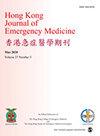同步30次按压-2次通气与异步110/min按压-10/min通气的心肺复苏的比较:人体模型研究
IF 0.8
4区 医学
Q4 EMERGENCY MEDICINE
引用次数: 0
摘要
背景:当根据当前指南进行评估时,使用袋阀面罩进行通气的复苏的CPR模型构成了一个讨论。目的:本研究旨在比较同步(30-2)通气-压缩法和异步110/min压缩-10/min通气在心脏骤停中的作用,在这种情况下,没有应用先进的气道管理,并且通过人体模型上的袋阀面罩提供通气。方法:该模拟试验使用两种临床心肺复苏方案进行:一种是异步方案,当按每分钟110次按压时,每分钟异步通气10次,另一种是同步方案,其中30次按压:同步通气2次。共有50组100人在人体模型上应用了这两种场景。记录了两种情况下的通气和压缩数据。结果:共有50组对两种方案的压缩标准进行了评估,就除压缩分数外的所有标准而言,两种方案之间没有统计学差异(p > 0.05)。发现异步场景中的压缩分数值在统计学上显著高于同步场景(96.02 ± 2.35,81.34 ± 4.42,p < 0.001)。评估总共50组在两种情况下进行的通气标准;所有标准均存在统计学上的显著差异。异步情景的平均通气率在统计学上高于同步情景(7.22 ± 2.42、5.08 ± 0.75,p < 0.001)。同步情景的平均通气量在统计学上高于异步情景(353.24 ± 45.46527.40 ± 96.60,p < 0.001)。在足够容量的同步情况下,通气率在统计学上高于异步情况(36.84 ± 14.47,75.00 ± 21.24,p < 0.001)。在统计上,低于异步情景的最小容量限制的通气率高于同步情景(62.48 ± 14.72、17.86 ± 19.50,p < 0.001)。结论:在我们的研究中,我们得出结论,同步方法应用的心肺复苏达到了更好的通气量。在评估压迫的任何中断时,需要进行全面的研究来揭示哪些患者会从这一结果中受益。本文章由计算机程序翻译,如有差异,请以英文原文为准。
Comparison of cardiopulmonary resuscitation that applied synchronous 30 compressions–2 ventilations with that applied asynchronous 110/min compression–10/min ventilation: A mannequin study
Background: CPR model of a resuscitation to be ventilated with a bag valve mask constitutes a discussion when evaluated with the current guidance. Objective: This study aims to compare the synchronous (30–2) ventilation–compression method with asynchronous 110/min compression–10/min ventilation in cardiac arrests where an advanced airway management is not applied and where ventilation is provided by a bag valve mask on a mannequin. Methods: This simulation trial was performed using two clinical cardiopulmonary resuscitation scenarios: an asynchronous scenario with 10 ventilations per minute asynchronously when compression is applied as 110 compression per minute and a synchronous scenario in which 30 compressions:2 ventilations were performed synchronously. A total of 100 people in 50 groups applied these two scenarios on mannequin. Ventilation and compression data of both scenarios were recorded. Results: Evaluating the compression criteria in both the scenarios performed by 50 groups in total, in terms of all criteria except compression fraction, there was no statistically difference between the two scenarios (p > 0.05). Compression fraction values in the asynchronous scenario were found to be statistically significantly higher than the synchronous scenario (96.02 ± 2.35, 81.34 ± 4.42, p < 0.001). Evaluating the ventilation criteria in both the scenarios performed by 50 groups in total; there was a statistically significant difference in all criteria. Mean ventilation rate of the asynchronous scenario was statistically higher than the synchronous scenario (7.22 ± 2.42, 5.08 ± 0.75, p < 0.001). Mean ventilation volume of the synchronous scenario was statistically higher than the asynchronous scenario (353.24 ± 45.46, 527.40 ± 96.60, p < 0.001). Ventilation ratio in sufficient volume of the synchronous scenario was statistically higher than the asynchronous scenario (36.84 ± 14.47, 75.00 ± 21.24, p < 0.001). Ventilation ratio below the minimum volume limit of the asynchronous scenario was statistically higher than the synchronous scenario (62.48 ± 14.72, 17.86 ± 19.50, p < 0.001). Conclusion: In our study, we concluded that the cardiopulmonary resuscitation applied by the synchronous method reached better ventilation volumes. Evaluating together with any interruption in compression, comprehensive studies are needed to reveal which patients would benefit from this result.
求助全文
通过发布文献求助,成功后即可免费获取论文全文。
去求助
来源期刊

Hong Kong Journal of Emergency Medicine
EMERGENCY MEDICINE-
CiteScore
1.50
自引率
16.70%
发文量
26
审稿时长
6-12 weeks
期刊介绍:
The Hong Kong Journal of Emergency Medicine is a peer-reviewed, open access journal which focusses on all aspects of clinical practice and emergency medicine research in the hospital and pre-hospital setting.
 求助内容:
求助内容: 应助结果提醒方式:
应助结果提醒方式:


